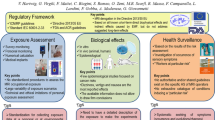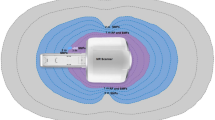Abstract
The exposure of MRI staff to SMFs and RF fields in the MRI units happen as a result of their induced movement in the MRI room during patients’ examination. Exposure to SMFs among health care workers has been associated with vertigo, nausea, increased heart rate, hypothermia and metallic taste in the mouth. The only known adverse effects associated with RF fields’ exposure include induced tissue heating, and the scientific arguments regarding non-thermal effects are inconclusive. The emission of MRI-related electromagnetic fields and exposure of workers to RF energy and SMFs can be reduced through implementation of reasonably practicable control measures. This study attempts to recommend the hierarchy of controls that can be implemented in the MRI units to reduce emissions and exposure of MRI staff to RF energy and SMFs. The controls are recommended based on exposure assessment conducted to quantify the exposure levels and self-reported priori-related and unrelated health consequences. In the MRI units, elimination is an impractical measure, hence, the implementation of engineering and administrative control measures as well as the utilisation of personal protective equipment (PPE) are recommended to mitigate exposure. Engineering controls include modification of MRI scanners to reduce emissions while administration controls include the design of work schedules and processes to be adaptive by MRI staff. PPE is recommended as a last resort and include protective equipment that are fit to reduce exposure arriving to workers. In South Africa, there is no legislation to assist in enforcing exposure limits and as a result, exposure levels are not monitored. The model of this kind could assist in reducing exposure levels in the MRI units and substantially reduce exposure-related effects amongst workers.












Similar content being viewed by others
References
Formica, D and Silvestri, S. 2004. Review: Biological effects of exposure to magnetic resonance imaging: an overview. BioMedical Engineering, 3. http://www.biomedical-engineeringonline.com/content/3/1/11
Scientific and Technological Options Assessment (STOA). 2001. Directorate for general for research-European Parliament: The physiological and environmental effects of non-ionizing electromagnetic radiation. Final study.
Ordidge RJ, Shellock FG, Kanal E. A Y2000 update of current safety issues related to MRI. J Magn Reson Imaging. 2000;12:1.
Hartwig V, Romeo S, Zeni O. Occupational exposure to electromagnetic fields in magnetic resonance environment: basic aspects and review of exposure assessment approaches. Med Biol Eng Comput. 2018. https://doi.org/10.1007/s11517-017-1779-7.
Schaap K, Christopher-De Vries Y, Slottje P, Kromhout H. Inventory of MRI applications and workers exposed to MRI-related electromagnetic fields in the Netherlands. Eur J Radiol. 2013;82(12):2279–85. https://doi.org/10.1016/j.ejrad.2013.07.023.
Shellock, F.G and Crues, J.V. 2014. MRI bioeffects, safety, and patient management. Biomedical Research Publishing Group, Los Angels.
Shigemitsu T, Ueno S. Biological and health effects of electromagnetic fields related to the operation of MRI/TMS. Spine. 2017;7:1740009. https://doi.org/10.1142/S2010324717400094.
Karpowicz J, Gryz K. Practical aspects of occupational EMF exposure assessment. Environmentalist. 2007;27:525–31.
Mild K, Alanko T, Decat G, Falsaperla R, Gryz K, Hietanen M, et al. Exposure of workers to electromagnetic fields. A review of open questions on exposure assessment techniques. Int J Occup Saf Ergon. 2009;15(1):3–33.
De Vocht F, Batistatou E, Mölter A. Transient health symptoms of MRI staff working with 1.5 and 3.0 tesla scanners in the UK. Eur J Radiol. 2015a;25(9):2718–26. https://doi.org/10.1007/s00330-015-3629-z.
Schaap K, Christopher-De Vries Y, Cambron-Goulet E, Kromhout H. Work-related factors associated with occupational exposure to static magnetic stray fields from MRI scanners. Magn Reson Med. 2016a;75(5):2141–55. https://doi.org/10.1002/mrm.25720.
Alorainy IA, Albadr FB, Abujamea AH. Attitude towards MRI safety during pregnancy. Ann Saudi Med. 2006;26(4):306–9. https://doi.org/10.5144/0256-4947.2006.306.
Patenaude Y, Pugash D, Lim K, Morin L. Diagnostic imaging committee, Society of Obstetricians and Gynaecologists of Canada: the use of magnetic resonance imaging in the obstetric patient. J Obstet Gynaecol Can. 2014;36(4):349–63. https://doi.org/10.1016/S17012163(15)30612-5.
Sammet S. Magnetic resonance safety. Abdom Radiol. 2016;41(3):444–51. https://doi.org/10.1007/s00261-016-0680-4.
Raphela, S.F. 2013. Occupational exposure to electromagnetic fields in the heavy engineering CO2 welding industry in the Mangaung Metropolitan municipality. D.Tech Thesis, Bloemfontein Central University of Technology, Free State.
Harmse, L.J. 2007. Occupational Hygiene: Physical Agents. Volume 2 of Occupational health and safety, Edition 2. ISBN 0958503818. Tshwane University of Technology, Pretoria.
Murbach M, Zastrow E, Neufeld E, Cabot E. Heating and safety concerns of the radio-frequency field in MRI. Current Radiology Reports. 2015;3:45.
Glover PM, Cavin I, Qian W, Bowtell R, Gowland PA. Magnetic-field-induced vertigo: a theoretical and experimental investigation. Bioelectromagnetics. 2007a;28(5):349–61. https://doi.org/10.1002/bem.20316.
Schaap K, Christopher-De Vries Y, Crozier S, De Vocht F, Kromhout H. Exposure to static and time-varying magnetic fields from working in the static magnetic stray fields of mri scanners: a comprehensive survey in the Netherlands. Ann Occup Hyg. 2014;58:1094–110.
De Vocht F, Batistatou E, Molter A, Kromhout H, Schaap K, van Tongeren M. Transient health symptoms of mri staff working with 1.5 and 3.0 T scanners in the UK. Eur J Radiol. 2015b;25:2718–26.
Chakeres DW, De Vocht F. Static magnetic field effects on human subjects related to magnetic resonance imaging systems. Prog Biophys Mol Biol. 2005;87(2–3):255–65.
Safe Work Australia. 2011. How to manage work health and safety risks. Code of Practice. Australia.
South Africa. 1993. Occupational health and safety act, act no. 85. Government Printer, Pretoria.
McRobbie DW. Review: occupational exposure in MRI. Br J Radiol. 2012;85:293–312.
Fatahi M, Karpowicz J, Gryz K, Fattahi A, Rose G, Speck O. Evaluation of exposure to (ultra) high static magnetic fields during activities around human MRI scanners. MAGMA. 2017;30(3):255–64.
Batistatou E, Mölter A, Kromhout H, van Tongeren M, Crozier S, Schaap K, et al. Personal exposure to static and time-varying magnetic fields during MRI procedures in clinical practice in the UK. Occup Environ Med. 2016;73(11):779–86.
Gowland PA. Present and future magnetic resonance sources of exposure to static fields. Prog Biophys Mol Biol. 2005;87(2-3):175–83.
Frankel, J., Wilén, J and Hansson-Mild, K. 2018. Assessing Exposures to Magnetic Resonance Imaging’s Complex Mixture of Magnetic Fields for In Vivo, In Vitro, and Epidemiologic Studies of Health Effects for Staff and Patients. Frontiers in public health. 6; 66.
Frankel, J., Hansson-Mild, K and Wilén, J. 2015. Assessment of MRI patient exposure for epidemiological studies. Joint Meeting of the Bioelectromagnetics Society and the European BioElectromagnetics Association, BioEM2015. Asilomar, CA: in 2015. 58.
Shellock FG. Radiofrequency energy-induced heating during MR procedures: a review. J Magn Reson Imaging. 2000;12(1):30–6.
Tsai LL, Grant AK, Mortele KJ, Kung JW, Smith MP. A practical guide to MR imaging safety: what radiologists need to know. Radiographics. 2015;35(6):1722–37.
Westbrook, C., Kaut Roth, C and Taibot, C. 2005. Magnetic Resonance Imaging (MRI) in practice. Third (3rd) edition. Blackwell Science Ltd. Blackwell Publishing Ltd. ISBN- 13:978-14051-2787-5.
EU Directive. 2013. 2013/35/EU of the European Parliament And Of The Council of 26 June 2013 on the minimum health and safety requirements regarding the exposure of workers to the risks arising from physical agents (electromagnetic fields).
Ichikawa M, Okazaki M. A magnetic shielding type superconducting fault current limiter using a Bi2212 thick film cylinder. IEEE Trans Appl Supercond. 1995;5(2):1067–70. https://doi.org/10.1109/77.402736.
Brzeziński T., Rybicki T., Malinowska G., Karbownik I., Rybicki E and Lech Szugajew L. 2009. Effectiveness of Shielding Electromagnetic Radiation, and Assumptions for Designing the Multi-layer Structures of Textile Shielding Materials. FIBRES & TEXTILES in Eastern Europe. 17, 1; (72) 60-65.
Health and Safety Executives. 2016. Electromagnetic fields at work, HSG281 (First edition). A guide to the Control of Electromagnetic Fields at Work Regulations.
Koh D, Aw TC. Surveillance in occupational health. Occup Environ Med. 2003;60:705–10.
Lele DV. Occupational health surveillance. Indian j occup environ med. 2018;22(3):117.
Franco G, Mora E, Perduri R. Focusing ethical dilemmas of evidence-based practice in SMF-exposed MRI-workers: a qualitative analysis. Int Ach Occup Environ Health. 2010;83:417–21. https://doi.org/10.1007/s00420-009-0476-8.
Baker EL, Matte TP. Chapter 13- surveillance of occupational illness and injury. In: Halperin W, Baker EL, Monson RR, editors. Public health surveillance. New York: Van Nostrand Reinhold; 1992. p. 178–94.
Occupational Safety and Health Administration. 1904. Revised Injury and Illness Recordkeeping Rules 29 CFR 1904.
National Institute for Occupational Safety and Health (NIOSH). 1998. Criteria for a recommended standard—occupational noise exposure. (Publication No. 98-126). Cincinnati, OH, USA: DHHS.
Sorawit Y, Suebsak N. Heuristic job rotation procedures for reducing daily exposure to occupational hazards. Int J Occup Saf Ergon. 2008;14(2):195–206.
Cheng KB, Ramakrishna S, Lee KC. Electromagnetic shielding effectiveness of copper/glass fiber knitted fabric reinforced polypropylene composites. Compos A App Sci Manuf. 2000;31:1039–45.
Perumalraj R, Nalankilli G, Dasaradan BS. Textile composite materials for EMC. J Reinf Plast Compos. 2010;29(19):2992–3005. https://doi.org/10.1177/0731684410363181.
Less EMF. 2018. Magnetic field shielding. Less EMF Inc. Accessed on 07/12/2018. Available at: http://www.lessemf.com/mag-shld.html.
World Health Organisation (WHO). 1999. Electromagnetic fields and public health radars and human health. Fact sheet No 226.
Bhattacharjee S. Protective measures to minimize the electromagnetic radiation. Electron Electric Eng. 2014;4(4):375.
Vitale L. 2018. Guide to solving AC power EMF problems in commercial buildings. Accessed on 07/12/2018. Available at: http://www.vitatech.net.
Karpowicz J, Gryz K. Health risk assessment of occupational exposure to a magnetic field from magnetic resonance imaging devices. Int J Occup Saf Ergon. 2006;12(2):155–67. https://doi.org/10.1080/10803548.2006.11076679.
Rathebe, P.C. 2018. A Narrative Review on Occupational Exposure to Radiofrequency Energy from Magnetic Resonance Imaging: A Call for Enactment of Legislation (Conference paper). 2018 Open Innovations Conference. Johannesburg, 170-175. DOI: https://doi.org/10.1109/OI.2018.8535960
Schaap K, Portengen L, Kromhout H. Exposure to MRI related magnetic fields and vertigo in MRI workers. Occup Environ Med. 2016b;73(3):161–6. https://doi.org/10.1136/oemed2015-103019.
Wilén J, De Vocht F. Health complaints among nurses working near MRI scanners--a descriptive pilot study. Eur J Radiol. 2011;80(2):510–3. https://doi.org/10.1016/j.ejrad.2010.09.021.
Karpowicz J, Hietanen M, Gryz K. Occupational risk from static magnetic fields of MRI scanners. Environmentalist. 2007;27:533–8. https://doi.org/10.1007/s10669-007-9064-1.
De Vocht F, Liket L, De Vocht A, Mistry T, Glover P, Gowland P, et al. Exposure to alternating electromagnetic fields and effects on the visual and visuomotor systems. Br J Radiol. 2007a;80(958):822–8. https://doi.org/10.1259/bjr/22263979.
Atkinson IC, Renteria L, Burd H, Pliskin NH, Thulborn KR. Safety of human MRI at static fields above the FDA 8 T guideline: sodium imaging at 9.4 T does not affect vital signs or cognitive ability. J Magn Reson Imaging. 2007;26:1222–7.
Glover PM, Eldeghaidy S, Mistry T, Gowland PA. Measurement of visual evoked potential during and after periods of pulsed magnetic field exposure. J Magn Reson Imaging. 2007b;26:1353–6.
De Vocht F, Stevens T, van Wendel De Joode B, Engels H, Kromhout H. Acute neurobehavioral effects of exposure to static magnetic fields: analyses of exposure-response relations. J Magn Reson Imaging. 2006;23:291–7.
Antunes A, Glover PM, Li Y, Mian OS, Day BL. Magnetic field effects on the vestibular system: calculation of the pressure on the cupula due to ionic current-induced Lorentz force. Phys Med Biol. 2012;57(14):4477–87. https://doi.org/10.1088/0031-9155/57/14/4477.
De Vocht F, Stevens T, Glover P, Sunderland A, Gowland P, Kromhout H. Cognitive effects of head-movements in stray fields generated by a 7 tesla whole-body MRI magnet. Bioelectromagnetics. 2007b;28(4):247–55.
Norris DG. High field human imaging. J Magn Reson Imaging. 2003;18:519–29.
Author information
Authors and Affiliations
Corresponding author
Ethics declarations
Conflict of interest
The authors declare no conflict of interest.
Ethical approval
Ethical clearance was obtained from the Health Sciences Research Ethics Committee of the University of the Free State (reference number: UFSHSD2018/0438).
Additional information
Publisher’s note
Springer Nature remains neutral with regard to jurisdictional claims in published maps and institutional affiliations.
Rights and permissions
About this article
Cite this article
Rathebe, P., Weyers, C. & Raphela, F. A health and safety model for occupational exposure to radiofrequency fields and static magnetic fields from 1.5 and 3 T MRI scanners. Health Technol. 10, 39–50 (2020). https://doi.org/10.1007/s12553-019-00379-4
Received:
Accepted:
Published:
Issue Date:
DOI: https://doi.org/10.1007/s12553-019-00379-4




